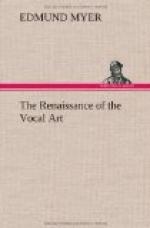It is wonderfully strange that this idea or principle of flexible, vitalized bodily position and action is not better understood by the vocal profession. That a right use or training of the body, automatically influences form and adjustment, and secures right conditions of tone, has been and is being demonstrated day by day. This is a revelation to many who have tried to sing by the rigid or limp methods. There is really nothing new claimed for it, for it is as old as the hills. Truth is eternal, and yet a great truth may be lost to the world for a time. The only things new which we claim, are the movements and the simple and effective devices used to study and apply them. These movements have a wonderful influence on the voice, for the simple reason that they are based upon Nature’s laws and common sense. These truths are destined to influence, sooner or later, the entire vocal world.
A great truth cannot always be suppressed, and some day someone will present these truths in a way that will compel their recognition. They are never doubted now by those who understand them, and they are appreciated by such to a degree of enthusiasm. I am well aware that when these movements are spoken of in the presence of the followers of the prevailing rigid or limp schools, they exclaim, “Why, we do the same thing. We use the body too.” Of course they use the body, but it is by no means the same. Their use of the body is often abuse, and not only of the body, but of the voice as well.
The influence on the singing voice of a rightly used or rightly trained body is almost beyond the ability of man to put in words.
All singing should be rhythmical. These flexible bodily movements develop rhythm.
All singing should be the result of vitalized energy and never of muscular effort. These movements arouse energy and make direct effort unnecessary.
Singing should be restful, should be the result of power in repose or under control. These movements, and these movements alone, make such conditions possible.
All singing should be idealized, should be the result of self-expression, of an expression of the emotions. This is impossible except through correct bodily action. “By nature the expression of man is his voice, and the whole body through the agency of that invisible force, sound, expresses the nobility, dignity, and intellectual emotions, from the foot to the head, when properly produced and balanced. Nothing short of the whole body can express this force perfectly in man or woman.”
These movements develop in a common-sense way the power of natural forces, of all the forces which Nature has given to man for the production and use of the voice. Rigid, set muscles, or relaxed, limp muscles dwarf and limit in every way the powers of the singer, physical, mental, and emotional; the physical action is wrong, the thought is wrong, and the expression is wrong. A trained, developed muscle responds to thought, to right thought, in a free, natural manner. A rigid or limp muscle is, in a certain sense, for the time being, actually out of use.




